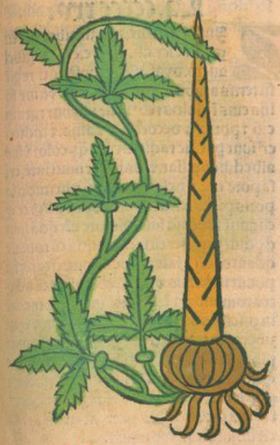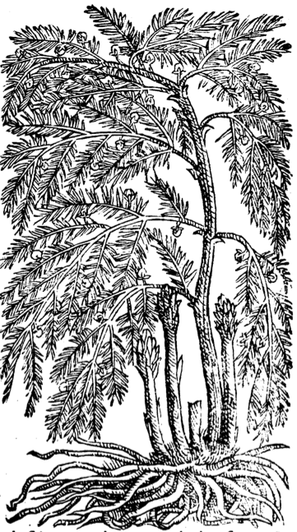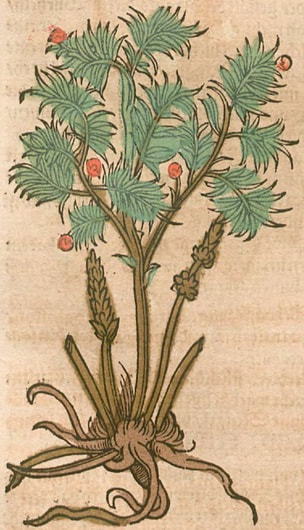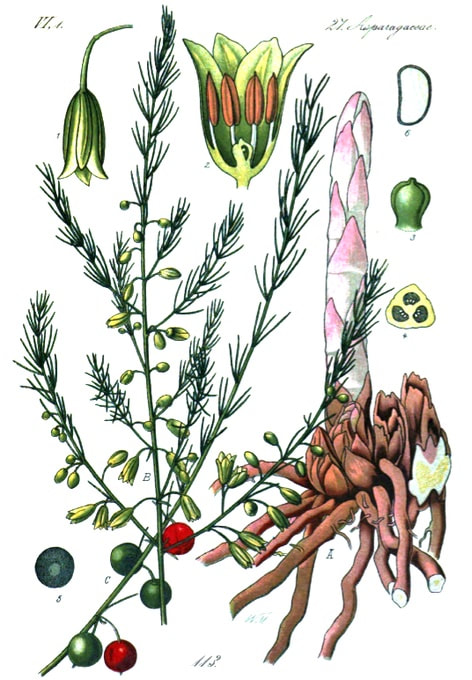Ortus Sanitatis, Meydenbach, 1491
|
Della Materia Medicinale, Andrea Valuassori, 1562
|
Krauterbuch, Lonitzer, 1578
|
Flora von Deutschland, Kohler, 1886
Asparagus root Tian Men Dong (Adam 2023)
Botanical name:
Asparagus officinale; the wild is A. tenuifolia
Three types were recognised in the West:
All traditions use varieties of Asparagus root, all being synonymous in use to A. officinalis with the exception of A. racemosus (Shatavari) which is similar, but slightly different.
Parts used:
Root; rarely the seed
Temperature & Taste:
Warm, moist. Sweet (Unani, Tibetan Medicine)
Some, including TCM, regarded it as Cool and Moist.
Classification:
2A APERIENT MEDICINES. 2G. CLEANSING
3G. EMMENAGOGUE. 3H. LACTAGOGUE. 3I. APHRODISIAC.
3J. INCREASE SEMEN. 3M. ARTHRITIC
4b. OPTHALMICS. 4e. STOMACHIC. 4g. HEPATIC. 4h. NEPHRITIC.
4j. NERVINE
Asparagus officinale; the wild is A. tenuifolia
Three types were recognised in the West:
- Garden
- Wild
- Ferny
All traditions use varieties of Asparagus root, all being synonymous in use to A. officinalis with the exception of A. racemosus (Shatavari) which is similar, but slightly different.
- TCM: A. cochinchinensis and others (Tian Men Dong)
- Tibetan Medicine also uses A. adscendens and A. tibeticus
- Ayurveda uses 2 varieties of Asparagus root:
- A. adscendens (White Musali, used as A. officinale);
- A. racemosus (Shatavari (see separate entry)
Parts used:
Root; rarely the seed
Temperature & Taste:
Warm, moist. Sweet (Unani, Tibetan Medicine)
Some, including TCM, regarded it as Cool and Moist.
Classification:
2A APERIENT MEDICINES. 2G. CLEANSING
3G. EMMENAGOGUE. 3H. LACTAGOGUE. 3I. APHRODISIAC.
3J. INCREASE SEMEN. 3M. ARTHRITIC
4b. OPTHALMICS. 4e. STOMACHIC. 4g. HEPATIC. 4h. NEPHRITIC.
4j. NERVINE
ADVERTISEMENT:
Uses:
1. One of the Five Opening Roots:
-for obstructions; cleanses and opens the Liver, Spleen and Kidneys
-opens the body: gently promote urine and bowel movement; constipation with dryness and deficiency
-promotes Urine; Edema; hot, painful or dribbling Urine
-Gravel, Stones
-"removes all kinds of visceral obstructions, especially those of the liver and kidney" (Avicenna)
2. Strengthens Kidneys and Liver, Nourishes Yin:
-Kidney and lower back pain; weak knees and legs; chronic Joint Pain; tightness of the ligaments (TCM, West)
-pains of the Lower Body from deficiency
-Seminal Emission, Impotence; promotes Sexual desire
-Deficient Heat; Consumption, Wasting
-"Its decoction is taken orally in cases of back pain and Sciatica" (Avicenna)
-"increases the quantity of Semen and also improves Libido... also useful in cases of difficulties in conception" (Avicenna)
-Rasayana: Nourishes the 7 Bodily Constituents; increases Semen and Essence (Ayurveda)
-'reinforces the Bone and Marrow' (Shen Nong Ben Cao)
-'It moistens the Five Viscera, tonifies five overstrains and seven impairments' (Da Ming)
-'After having such drugs over 100 days, the person will get very strong'. (Zhang Yu Xi)
3. Nourishes the Blood, Promotes Circulation:
-anemia, weakness
-scanty Menstruation; used for Menstrual disorders with deficiency
-Infertility, Threatened Miscarriage
-Varicose veins, Hemorrhoids
-improves Eyesight
-'nourishes the Skin and Muscle' (Ming Yi Bie Lu)
-'Take the decoction to beautify one’s skin by making the skin whiter, more lustrous and cleaner'. (Zhen Quan)
4. Moisten and Strengthen the Lungs, clears Lung Heat:
-chronic cough, cough with Bloody sputum, chronic Bronchitis, Whooping Cough
-'good for treating coughing with dyspnea due to the Lung Qi disorder, or Asthma with dyspnea, pulmonary flaccidity with carbuncle and the spitting of pus'. (Zhen Quan)
5. Nourishes Yin, Stops Wind:
-Epilepsy, Hysteria, Apoplexy, Cramps, Numbness, Spasms
-Brain and Memory tonic; increases Intellect
-'good for treating arthralgia and hemiplegia due to attack of pathogenic Wind and Damp'. (Shen Nong Ben Cao)
-'Long¬term use enables one to feel happy and vigorous and enjoy a long life' (Shen Nong Ben Cao)
6. Used for Cancer:
-Recently the spears and roots have been advocated in Cancer treatment.
7. Externally:
-root decoction gargled for Toothache and spongy gums
-in hip-baths or baths for all pains of the lower body (Culpeper)
-root is steeped in wine or vinegar for Dislocations (Dioscorides)
-concentrated decoction is 'extremely effective' against Freckles (Norbu)
ADVERTISEMENT:
Dose:
Powder: 2–5 grams
Decoction: 6–12 grams
Corrective:
... available in PRO version
Substitute:
... available in PRO version
Powder: 2–5 grams
Decoction: 6–12 grams
Corrective:
... available in PRO version
Substitute:
... available in PRO version
Main Combinations:
Asparagus and Parsley root
Opening Roots - Five & Two
1. One of the Five Opening Roots: with roots of Celery, Parsley, Broom and Fennel, primarily used to strengthen and open the lower body, promote urine and bowel movements.
2. To Open the Liver, Asparagus root ... available in PRO version
3. Liver Heat and Inflammation, Asparagus root with ... available in PRO version
4. Skin diseases, Acne, Boils, Eczema, Asparagus root with ... available in PRO version
5. Nourish the Yin, combine Asparagus root with ... available in PRO version
6. Urinary diseases with Yin deficiency: combine Asparagus root with ... available in PRO version.
7. Yin deficient Heat: combine Asparagus root with ... available in PRO version
8. Wind associated with Yin deficiency, Asparagus root with ... available in PRO version
9. Vertigo, Asparagus root with ... available in PRO version
10. Paralysis, combine Asparagus root with ... available in PRO version
11. Chronic Cough, Cough Asparagus root with ... available in PRO version
12. Aphrodisiac, combine Asparagus root with ... available in PRO version
13. Pediatric tonic: combine Asparagus root with ... available in PRO version
Major Formulas
Syrup of Five Opening Roots
Electuary for Back Pain (Galen)
Hepatic Decoction (Hoffman)
Syrup of Chicory and Rhubarb (Nicholas)
Syrup of Marshmallow (Fernel)
Syrup of Mugwort (Augustana)
Wine for Scrophula (Renodeus)
Tincture for Paralysis
Dhatuvallabha Churna (Ayurveda)
Cautions:
Generally safe. Best not used in Phlegm and Damp conditions.
Main Preparations used:
Distilled Water of the whole fresh; often used as one of the Five Opening Roots.
Generally safe. Best not used in Phlegm and Damp conditions.
Main Preparations used:
Distilled Water of the whole fresh; often used as one of the Five Opening Roots.
ADVERTISEMENT
Click the Tabs above for more information on this Medicine
|
'Asparagus was well known to the Greeks and Romans both wild and in a cultivated state. Hippocrates mentions it in his treatise on diet, and in his treatise on the Diseases of Women he says that the berries taken in wine promote conception. Dioscorides and Pliny describe its medicinal properties, and Cato (De re Rust. c. 161) gives full directions concerning its cultivation. The ancients considered it to be a wholesome vegetable, dispelling flatulency and acting as a mild aperient, diuretic and aphrodisiac. They administered the root in wine for calculous affections and pains in the uterus, and also considered it beneficial in elephantiasis. Ibn Sina calls it haliun and quotes Galen's opinion of its medicinal value.
The Western Arabs call it Isferaj; in Persia it is known as Marchubeh and Margiyeh "snake wort," from its being considered to be an antidote for snake poison. Wild asparagus, the A. tenuifolius of Linnaeus, was |
known to the Romans as Corruda, a name still current in the south of France, where the plant is valued for its medicinal properties up to the present time. Broussais considered asparagus to be a sedative in palpitation of the heart, and it is still used in France as a diuretic in cardiac dropsy and chronic gout. The young shoots when eaten as a vegetable are well known to communicate a peculiar and offensive odour to the urine, a syrup for medicinal use is prepared with their juice, 100 parts after clarification being added to 190 parts of sugar.
Some physicians consider asparagus to be useless as a diuretic and even injurious to the bladder, but as far as our experience goes it has no ill-effects when taken daily for a considerable time. Indian Mahometan writers on medicine merely retail what the ancients have said about this plant; they usually prescribe the dried berries which are to be found in the bazars of all large towns'. (Pharmacographia Indica, Dymock, 1893) |








